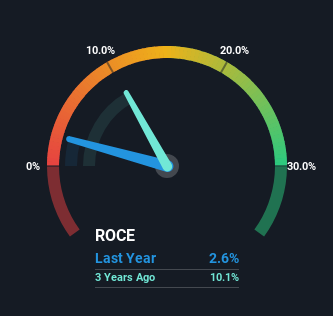- Israel
- /
- Construction
- /
- TASE:SPEN
Some Investors May Be Worried About Shapir Engineering and Industry's (TLV:SPEN) Returns On Capital
Finding a business that has the potential to grow substantially is not easy, but it is possible if we look at a few key financial metrics. In a perfect world, we'd like to see a company investing more capital into its business and ideally the returns earned from that capital are also increasing. Put simply, these types of businesses are compounding machines, meaning they are continually reinvesting their earnings at ever-higher rates of return. However, after briefly looking over the numbers, we don't think Shapir Engineering and Industry (TLV:SPEN) has the makings of a multi-bagger going forward, but let's have a look at why that may be.
Return On Capital Employed (ROCE): What Is It?
For those who don't know, ROCE is a measure of a company's yearly pre-tax profit (its return), relative to the capital employed in the business. Analysts use this formula to calculate it for Shapir Engineering and Industry:
Return on Capital Employed = Earnings Before Interest and Tax (EBIT) ÷ (Total Assets - Current Liabilities)
0.026 = ₪276m ÷ (₪15b - ₪4.5b) (Based on the trailing twelve months to June 2024).
So, Shapir Engineering and Industry has an ROCE of 2.6%. In absolute terms, that's a low return and it also under-performs the Construction industry average of 8.1%.
Check out our latest analysis for Shapir Engineering and Industry

While the past is not representative of the future, it can be helpful to know how a company has performed historically, which is why we have this chart above. If you'd like to look at how Shapir Engineering and Industry has performed in the past in other metrics, you can view this free graph of Shapir Engineering and Industry's past earnings, revenue and cash flow.
What Can We Tell From Shapir Engineering and Industry's ROCE Trend?
When we looked at the ROCE trend at Shapir Engineering and Industry, we didn't gain much confidence. Over the last five years, returns on capital have decreased to 2.6% from 8.9% five years ago. On the other hand, the company has been employing more capital without a corresponding improvement in sales in the last year, which could suggest these investments are longer term plays. It's worth keeping an eye on the company's earnings from here on to see if these investments do end up contributing to the bottom line.
What We Can Learn From Shapir Engineering and Industry's ROCE
Bringing it all together, while we're somewhat encouraged by Shapir Engineering and Industry's reinvestment in its own business, we're aware that returns are shrinking. Unsurprisingly, the stock has only gained 26% over the last five years, which potentially indicates that investors are accounting for this going forward. Therefore, if you're looking for a multi-bagger, we'd propose looking at other options.
One final note, you should learn about the 4 warning signs we've spotted with Shapir Engineering and Industry (including 2 which are significant) .
While Shapir Engineering and Industry isn't earning the highest return, check out this free list of companies that are earning high returns on equity with solid balance sheets.
New: Manage All Your Stock Portfolios in One Place
We've created the ultimate portfolio companion for stock investors, and it's free.
• Connect an unlimited number of Portfolios and see your total in one currency
• Be alerted to new Warning Signs or Risks via email or mobile
• Track the Fair Value of your stocks
Have feedback on this article? Concerned about the content? Get in touch with us directly. Alternatively, email editorial-team (at) simplywallst.com.
This article by Simply Wall St is general in nature. We provide commentary based on historical data and analyst forecasts only using an unbiased methodology and our articles are not intended to be financial advice. It does not constitute a recommendation to buy or sell any stock, and does not take account of your objectives, or your financial situation. We aim to bring you long-term focused analysis driven by fundamental data. Note that our analysis may not factor in the latest price-sensitive company announcements or qualitative material. Simply Wall St has no position in any stocks mentioned.
About TASE:SPEN
Shapir Engineering and Industry
Engages in the construction, engineering, and infrastructure businesses in Israel.
Acceptable track record with low risk.
Market Insights
Community Narratives



